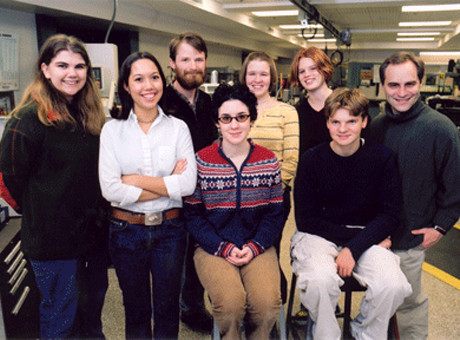Littleton High School InvenTeam
The town of Littleton, NH is bombarded with several feet of snow each winter. Snow removal costs the town an average of $3000 per storm, and the salt used is damaging to roads and the nearby Ammonoosuc River. In hopes of alleviating this problem, the Littleton InvenTeam decided on creating a sidewalk heating system for their Inventeam Grant project. The new system would offer the community a range of benefits including improved pedestrian safety and traffic flow, increased business activity on Main Street and a reduced cost of snow removal. The success of the project was dependent on cost, energy and maintenance efficiency. The Littleton InvenTeam planned to develop an underground, energy-efficient heating system that would help remove the snow and ice from the street and sidewalks during the winter. As they began their research, they explored alternative energy sources including solar, wind, geothermal, hydroelectric, compression pad and waste-heat generation. Waste-heat proved to be the winning energy source for this project. The test site was a large box covered with a cement sidewalk slab. The box was filled with three plumbing loops connected by two manifolds linked to a stove, which served as the heat source. The manifolds acted as a central connection point. The team ran a 50/50 glycol-water antifreeze solution through the system. This solution was chosen because background research indicated that this is the optimal fluid for outdoor snow melting systems. Indeed the fluid heated the test site to a temperature level warm enough to melt snow. Concentrated effort and communication from the start of the project were key factors in the InvenTeam's success. Littleton's first brainstorming session brewed dozens of disparate ideas for a snow removal system, before producing consensus on waste-heat. Since the InvenTeam was large, the members formed sub-teams, each focused on one aspect of the project. These "Student Research Groups" handled test bed construction and materials testing, heating system mechanics, the solar/wind/hydro components, and the waste heat compression pads. Littleton students made it a priority for the community to be aware of and become involved in the project. "We used every form possible to spread the word about our project: e-mail, the InvenTeam web site, the telephone, and word of mouth," noted one member. The InvenTeam received overwhelming assistance from community members, including town employees, school officials, and private businesses, plus 18 mentors. George Brodeur, the Clerk of the Works for the Littleton High School Renovation Project, had initially suggested the idea of testing the system in the new school sidewalks. The community supported the project through donations of materials and dedicating their time to help the InvenTeam achieve success. In June 2003, the Littleton InvenTeam held a groundbreaking ceremony to install the system in the new front sidewalks of the school as part of a major renovation. The system is hooked up to the school's boilers and is heated by waste-heat generated by the two boilers. Students will be able to test the efficiency of the system with one or two boilers running at different temperatures. Town officials are considering incorporating the InvenTeam's system in its Main Street renovation project, scheduled for 2005. A local woman has also inquired if the team could install the system in her driveway. The InvenTeam students are enthusiastic to see other potential applications for their system in the future.


